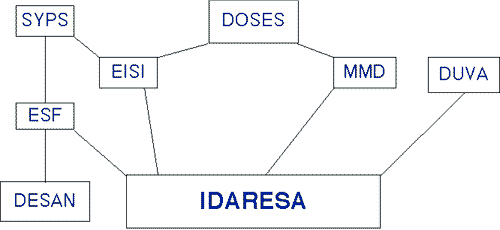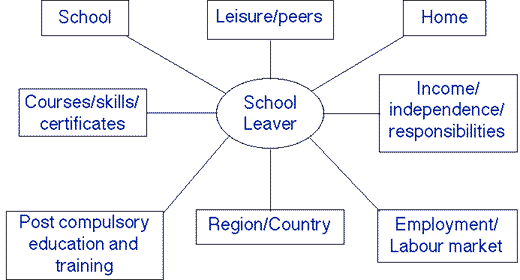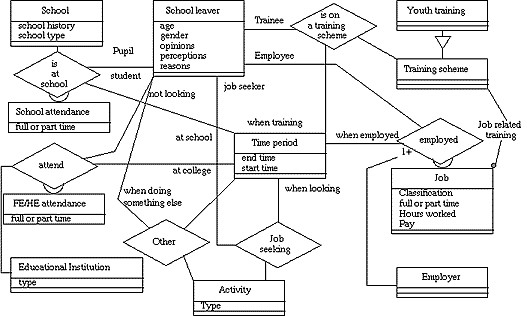

![]()
 Introduction
Introduction
 The Background to the Project
The Background to the Project
 The IDARESA Project
The IDARESA Project

Figure 1

Figure 2

Figure 3
 Conclusions
Conclusions
Karen Brannen and Joanne Lamb
Centre for Educational Sociology, University of Edinburgh
BRUIJN, E. de, FROISSART, C., GONZALEZ TIRADOS, R. M., HOWIESON, C., MANNING, S., ORTEGA GARCIA, P., RAFFE, D. & SPENCE, J. (1993) Current Issues in Modular Training: An Interview Study with Trainers in Six European Countries. Edinburgh: Centre for Educational Sociology, University of Edinburgh.
BRUIJN, E. de & HOWIESON, C. (1995) 'Modular Vocational Education and Training in Scotland and The Netherlands: Between Specificity and Coherence', Journal of Comparative Education, vol. 31, no. 1, pp. 83 - 99.
De VANEY, C., FLEMING, M., LAMB, J., MERSCH, G. & SANCHEZ, J. (1992) 'The Expert Interface to Statistical Information: Rationale, Techniques and Experiences', seminar on New Techniques and Technologies for Statistics, Bonn, 1992.
De VANEY, C., FLEMING, M., LAMB, J., MERSCH, G. AND SANCHEZ, J. (1993) 'Expert Interface to Statistical Information', EEC DOSES programme project no. B34, Final report, 1993.
DRAPPIER, J. DOSES - Its Evaluation Its Results Its Future. Luxembourg: Office for Official Publications of the European Communities.
EPPRECHT, E. (1992) 'An Approach for Knowledge Representation and Reasoning with Contextual Strategies in Knowledge-Based Statistical Consultancy Systems', unpublished PhD thesis, Facultes Universitaires Notre Dame de la Paix, 1992.
FROSCHL,K.A.: 'Towards an Operative View of Semantic Metadata', Proceedings of the Statistical Meta-Information Systems Workshop, Luxembourg.
HAND, D. J. (1993) 'Data, Metadata and Information', Proceedings of the Statistical Meta-Information Systems Workshop, Luxembourg.
HANNAN, D., LAMB, J. M., PAGRACH, K., RAFFE, D., RUTJES, J. J. (1994) Building a Cross-National Dataset on Transitions in Youth: An exploration using Data from Ireland, Scotland and the Netherlands. Scientific Network on Transitions in Youth Working Paper. Strasbourg: European Science Foundation.
HOWIESON, C., HURLEY, N., JONES, G. & RAFFE, D (1994) Determining the need for Vocational Counselling among different Target Groups of Young People under 28 years of age in the European Community: Young People in Full-Time Employment and Homeless Young People in the United Kingdom. A CEDEFOP Panorama National Report. Berlin: The European Centre for the Development of Vocational Training (CEDEFOP).
LAMB, J. M. (1989) 'Putting Semantics into Data Capture', paper presented to the Development of Statistical Tools seminar on 'The development of statistical expert systems', Luxembourg, December 1987. Eurostat News Special Edition 1989. Luxembourg: Office for Official Publications of the European Communities, catalogue number CA-AB-89-005-EN-C.
LAMB, J. M. (1993) 'Metadata in Survey Processing', Proceedings of the Statistical Meta-Information Systems Workshop, Luxembourg.
LAMB, J. M., RUTJES J. J. & PAGRACH, K. (1996) Quality Frames for a European Survey on Transitions in Youth. Paper for the European Scientific Foundation workshop on 'Linking Theory with Empirical Analysis in the study of Transitions in Youth', Marseilles.
RITCHIE, P. (1991) 'Design of a Conceptual Model for a Documentation Database', ESRC R000231293, Final report.
SUNDGREN, B. (1993) 'Modelling Meta-Information Systems', Proceedings of the Statistical Meta-Information Systems Workshop, Luxembourg.